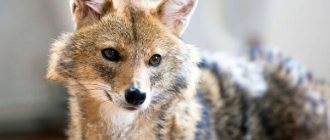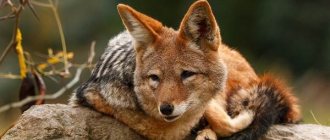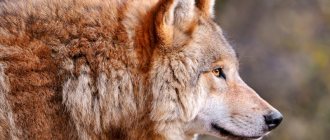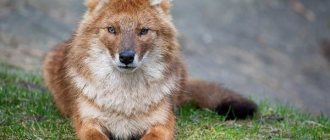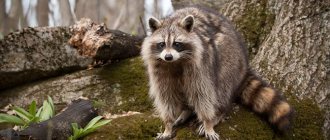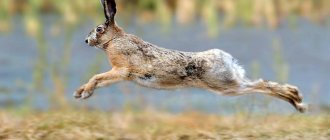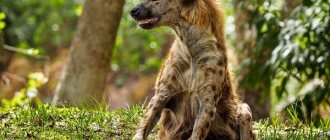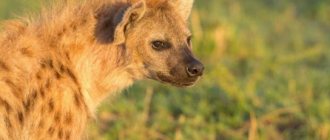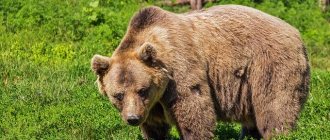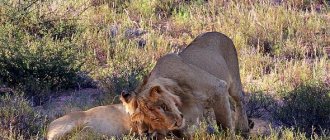When a person hears the word “jackal”, he has unambiguous associations and this is not surprising, since man has created the image of a cowardly animal, always ready to deceive. The fact that the image of this animal is far from positive can be learned by recalling some works of art. For example, in Kipling's work there is such a character named "Tobacco". This jackal is characterized as a cowardly animal who loves toadying. In fact, not everywhere in the world such animals were treated with contempt. The ancient Egyptians always depicted the god Anubis with the head of a jackal.
Scientific classification
- Kingdom: Animalia (animals)
- Phylum: Chordata
- Class: Mammalia (mammals)
- Order: Carnivora (predatory)
- Family: Canidae (canids)
- Genus: Canis (wolves)
- Species: Canis aureus (common jackal)
There are also two subspecies, which differ mainly in color and habitat:
- Canis aureus maeoticus - darker colored jackals found in southern Europe and the Mediterranean;
- Canis aureus aureus are light-colored jackals native to Central Asia, India and Iran.
In addition, due to their close relationship with coyotes and domestic dogs, which share the same set of chromosomes, jackals often interbreed with these members of the canid family.
Enemies and competitors of jackals in the wild
Currently, the enemies of jackals in their natural habitat are wolves and dogs. True, in some places dogs live quite peacefully with their relatives, and you can see how animals rummage through the same garbage heap. At a time when the numbers of tigers and leopards were much higher, they could also be classified as natural enemies. But at the same time, jackals often feasted on the remains of the prey of these predators.
People chase jackals when they annoy them, causing damage to livestock or gardens. If desired, a person can easily tame an animal, not only at a young age, but also as an adult. The animal behaves like an affectionate dog, following its owner everywhere and responding to his call.
The jackal's competitors in the wild are foxes, jungle cats, wolves, raccoons, and steppe cats.
Character traits
Appearance
Jackals are medium-sized canids and are considered the most typical member of the genus Canis. They have a slender body with long limbs. The muzzle is pointed, although slightly blunter than that of foxes.
Photo: RoundGlass Sustain
The fur is thick and hard, the hair is relatively short. , an abundant undercoat grows . The bushy tail is always pulled down. Females have 8 mammary glands, making up 4 pairs. There are 4 toes on the hind paws and 5 toes on the front paws. The claws are dull.
Coloring
The main fur color is golden , but the coat color can vary from light creamy yellow to dark brown depending on the season. The fur on the back is often a mixture of brown, black and white hairs, so jackals may appear to have a dark saddle.
Individuals living in rocky mountainous areas may have a grayer coat. The belly and underparts are a lighter shade of pale rufous to cream.
Photo: Kandukuru Nagarjun
The tail is thick, the tip is yellow-brown to black. Eye color varies from light yellow to bright amber.
Dimensions
This predator is comparable in size to an average dog. You could even say that this is a smaller version of an ordinary wolf.
- Body length (without tail): 70-85 cm
- Average tail length: 25 cm
- Shoulder height: 40-45 cm, maximum 50 cm
- Body weight: up to 10 kg (males), up to 7.8 kg (females)
- Average weight of newborns: 185 grams
Distribution range and habitat
Jackals have access to a wide range of habitats. They typically live in open grasslands, but are also found in deserts, forests, grasslands, mangroves, agricultural and rural habitats.
Photo: Capital Berg
Jackal populations are widespread in Northern and Eastern Africa, Europe, the Near and Middle East, and central, middle and southeastern Asia. The distribution ranges from sea level in Eritrea to 3,500 meters in the Bale Mountains of Ethiopia and 2,000 meters in India.
Small ancient Mediterranean populations , which later merged with jackal groups that came from Asia. Previously, jackals lived on the European continent only in Greece, Bulgaria and the countries of the former Yugoslavia. At the end of the last century, populations spread from South-Eastern Europe to Hungary, Romania, the Czech Republic, Slovakia, Austria, Italy, and Macedonia. The jackal also penetrated into the territory of Moldova and Ukraine.
- Geographical regions: Palearctic
- Terrestrial biomes: forest, grassland, savanna, desert
Home range
Photo: Crushpixel
Individuals maintain year-round personal territories of 0.5–7 square kilometers , traveling beyond these territorial boundaries to access fresh carcasses. Home range size may vary in some locations depending on habitat and age.
The boundaries and size of personal territories change over time. Adults expand their range of residence while searching for a partner and new feeding territories. The home ranges of individuals within a social group tend to overlap.
Jackal: description
Jackals are typical predators representing the Canidae family and the genus of wolves. At first glance, jackals are quite awkward animals, representing something between wolves and yard dogs. There are several varieties of jackals, therefore, in order to describe the animal, it is necessary to take into account the peculiar signs of differences.
Depending on the species, jackals are characterized by:
Common jackal (Canis aureus)
In appearance, common jackals are more reminiscent of ordinary wolves, but are smaller in size. The body length of this species reaches about 0.8 meters with a height at the withers of about 0.5 meters. Adults can weigh no more than 10 kilograms. The predominant color of the coat is gray, with the presence of red, yellowish and fawn inclusions. The back and side areas are always darker, and sometimes almost black. The belly area and lower part of the cervical region are lighter and are made in light gray or yellowish shades.
Striped jackal (Canis adustus)
Striped jackals are so called because they have light stripes on the sides of their bodies. The dorsal area of this species is colored brownish-gray, while the tail is darker with a white tip. This jackal has a somewhat shortened and wide muzzle, while its fangs are larger and more powerful. In the area of the muzzle, as well as closer to the anus, there are special glands that produce an odorous substance.
Black-backed jackal (Canis mesomelas)
Black-backed jackals are distinguished by their reddish-gray coat color and resemble striped jackals. The dorsal area is characterized by a darker color and forms something like a black saddle, which falls closer to the base of the tail. Despite the fact that the weight of these jackals is slightly larger (almost 13 kg), their size is almost identical to other species.
Ethiopian jackal (Canis simensis)
If we compare this species with other species, it is somewhat larger, since adult individuals weigh more than 15 kilograms, and their height at the withers reaches 60 centimeters, or even more.
Having received in our time unique tools for research at the genetic level, scientists were able to establish that Ethiopian jackals at one time descended from ordinary wolves, and striped and black-backed jackals - from wild dogs, as well as from wolves that lived in African and European countries. Asian continents about 7 million years ago.
Interesting facts about the Jackal
Appearance and features
It is quite natural that jackals, regardless of species, are characterized by common features, which distinguishes them from other animals. The head of this predator is relatively small (skull up to 20 cm long), with a sharp muzzle, while the muzzle has the shape of a triangle. The ears are relatively large with blunt tips. They are always in a protruding position, which makes them very noticeable. Eye color can be either light or dark. The fangs of this predator are quite sharp and thin, which allows the predator to cut the skin of the victim like knives.
Jackals can be compared not only to wolves and dogs, but also to coyotes, as well as ordinary mongrels. Its appearance is so unique that the jackal resembles a shabby, emaciated wolf or an unkempt stray dog. The legs of this predator are thin and long, while the body is strong, covered with short, bristly hair. The tail is quite fluffy and always lowered. The main color mainly depends on the natural living conditions.
Therefore, the main color could be like this:
- Light gray.
- Reddish.
- Brownish-red.
- Yellowish-gray.
- Dark gray.
Jackals molt 2 times a year - in spring and autumn. Molting lasts about two weeks. In summer, the coat of these predators is not as long and thick as in winter, and its color is more red.
In the belly area, on the chest, on the chin and the inner parts of the limbs, the hair is always lighter, with inclusions of yellow hairs.
The peculiarity of these predators is that they have a different number of fingers on their paws - the forelimbs are armed with five fingers each, and the hind limbs have 4 fingers. Each finger is armed with a short claw. Representatives of males are always larger and more massive compared to females.
Where do jackals live?
Jackals are found over very wide areas. This type of predator is found:
- In the vastness of South-Eastern Europe.
- In the territory of South Asia.
- In the Middle East.
- On the African continent.
These animals managed to adapt to life in various biotopes, so jackals are found in steppes and semi-deserts, as well as in humid forests and mountainous areas. In addition, this predator can settle next to human habitation. Jackals often migrate in search of food. As a result, they appear in new territories, where they then appear on a permanent basis. Recently, experts have noticed that the habitat of jackals has begun to move towards the northern regions. Therefore, it is not surprising that jackals appeared where they had never appeared before. If we talk about our territories, then previously jackals could be found in the forests of the Black Sea and Caspian coasts, while they were considered a very rare species of animals that lived in our territories. Experts have noticed that the total number of these animals in the 21st century in the Krasnodar Territory has increased significantly. After some time, these predators appeared on the territory of the Crimean Peninsula.
Jackals appeared on the territory of the Rostov region in 2002, after which they began to inhabit these new territories and, by 2015, there were quite a lot of them. Basically, they liked the Don River delta, since in the dense reed vegetation they could always find shelter and also find food. Local authorities turned to local hunters for help so that they would shoot jackals for a certain fee.
Jackals prefer to live among impassable thickets of various vegetation. Their lair is always located in the thickest vegetation, although, living in open spaces of semi-deserts, jackals have to burrow into the ground (dig holes). Living in mountainous terrain, jackals practically do not climb mountains higher than 1 thousand meters. It would be nice if there was a body of water near the habitat, although this condition is not mandatory.
It is very interesting that jackals are able to withstand frosts of up to 35 degrees, but moving through deep snow is a real test for them. This predator always moves along paths made by humans or other animals.
Interesting moment! All 4 species of these animals live on the African continent.
What does a jackal eat?
The jackals' menu includes a variety of foods. This predator tirelessly searches for food, going on a hunt either alone or in pairs to kill a larger animal. This animal is an excellent hunter, as it is capable of literally lightning-fast high jumps. As a result, their prey includes flying birds in the form of pheasants, hawks, coots, sparrows and waterfowl. In addition, jackals can appear on human farmsteads, where this predator steals chickens, turkeys, geese, kids, lambs and other living creatures.
In other words, the jackal's menu consists of all kinds of animals that live in the same territory as these predators. Jackals do not disdain rodents, lizards, frogs, or snakes. If you are lucky enough to catch it, the jackal can dine on fish. Their menu contains food items of plant origin, in the form of vegetables, fruits, berries, nuts, tubers and root systems. They quench their thirst by eating juicy melons and watermelons. When it is very hot, jackals move as close to the reservoir as possible, and when the reservoirs begin to dry up, these animals dig holes at the bottom of the reservoir to drink groundwater.
Jackals, oddly enough, are associated with scavenger animals, but this is not entirely true, since this predilection largely depends on the species. If we take the striped jackal, then its diet contains no carrion at all, and the predator gives preference to freshly caught prey in the form of rodents, insects, hare meat, etc., as well as fresh fruits. As for the common jackal, it does not disdain carrion, so it can often be seen in landfills along with vultures, in which carrion predominates in their diet.
Ethiopian jackals primarily feed on rodents, but they sometimes get lucky and snack on hare meat or small antelope. Nowadays, it is very difficult for jackals to get into pastures where livestock graze. In any case, we can safely say that jackals are omnivores.
The common jackal is an evil and cunning thief! The fittest predator!
How many years do jackals live
The life expectancy of striped jackals in the wild rarely exceeds twelve years, and the common jackal in the wild can easily live as long as fourteen years. Other subspecies of jackal also live for ten to twelve years.
Character and lifestyle
Jackals go hunting at dusk. During the daytime, these predators prefer to rest, hiding in their lairs. As for the Ethiopian jackal, on the contrary, it hunts more during the daytime. Coming out of their hiding places in search of food, these predators travel long distances, constantly searching. Jackals are still unique animals that catch carrion at a considerable distance. Before each such campaign, the animals begin to emit something like a battle cry, which for these animals represents a prolonged howl. As a rule, this howl is picked up by other relatives living in the same territory.
These predatory mammals live in married couples, and each pair can own its own territory, the area of which can reach five thousand or more hectares. This area is constantly marked. All strangers who appear within a specific territory and do not belong to a specific family are expelled, and in the most cruel way. As a rule, young animals also live with their parents, but only up to a certain point. When young jackals have formed pairs, they move away from their parents to find their own territories. In fact, due to their secretiveness, zoologists know little about the behavior of jackals, although it is known that jackals treat humans with distrust. Despite this, it was found that during periods of severe winters, these predators appeared near human habitation.
Interesting fact! Black-backed jackals are more likely than other species to make contact with humans, so they can be tamed, which indicates the trust of this species in humans. Naturally, to tame a jackal, you need to be a great specialist in this field. Jackals living in natural conditions live no more than 12 years, although in captivity some individuals lived at least 14 years.
It so happened that man created a negative, cowardly image of a jackal, although this is not true. A cowardly predator in the wild? Something is wrong here. In fact, jackals are very cautious animals, which is why they have been poorly studied. In jackal habitats where humans are not hostile to jackals, these predators can even allow humans to approach their offspring.
Jackals are not cowardly, they are quite curious, and even arrogant animals. Often people who had to stop for the night in jackal habitats were left without part of their food, without part of their wardrobe, etc. The jackals simply carried away what they liked from the camp. Is this a sign of cowardice? Most likely, these are high hunting characteristics, allowing you to literally take everything from under a person’s nose.
Reproduction and offspring
Almost all types of jackals, with the exception of the Ethiopian, form married couples once and for life. Both parents take care of family problems, from the moment of home arrangement to the upbringing of growing offspring. These are sensitive and caring family members, as well as parents. Jackals can make a den for themselves in abandoned burrows of foxes, badgers, porcupines, aardvarks, etc. If you are not lucky enough to find an abandoned hole, it does not matter. Jackals can dig a hole for themselves, setting it up as their lair. As a place for their home, jackals can use natural shelters in the form of old termite mounds, crevices, large hollows, or simply dense thickets of various vegetation. When living in burrows, animals equip a wide nesting chamber located at a depth of about one and a half meters.
If a female has to choose a family partner for the first time, then several partners begin to court her at the same time. Males have to sort things out among themselves and the most forceful methods are used. As a rule, the winner becomes her life partner forever.
Depending on their natural habitat, the mating season for jackals begins in January/February and lasts almost a month. This period is characterized by prolonged and frequent howling of individuals of different sexes.
If we talk about the time of day, then this indicator does not affect the mating season in any way. Animals are busy reproducing offspring, both at night and during the day. If a female mates for the first time, she may not get pregnant the first time. Therefore, after a few days, she gets another chance. If she is unlucky now, she will have to wait until next year. After fertilization, the female carries the future offspring for 57-70 days.
From 2 to 4 cubs are born, although up to 8 cubs can be born. Each cub weighs no more than 200 grams, and they cannot see, but their body is covered with soft fluffy down. As puppies grow, the color of their appearance changes, and guard hair also begins to grow. Somewhere around the two-week mark, the offspring begins to see. Somewhere around this period, the cubs begin to develop hearing. After another couple of weeks, the offspring gets to their feet, taking their first steps.
Until almost three months of age, the mother feeds the cubs with her milk. Common jackals accustom their offspring to the usual meat diet already on the 20th day after birth. To do this, they regurgitate food containing meat, offering a similar “cocktail” to their offspring. Teeth in the born offspring begin to appear after 2 weeks of life. This process lasts for almost six months. The offspring grows and develops quite quickly. In the first month of their life, they gain weight up to half a kilogram, and after another 3 months they weigh almost 3 kilograms, or even more.
Interesting to know! Females are ready to breed at the age of 1 year, and males mature somewhat later. Often, offspring live with their parents until they are 2 years old.
Natural enemies of jackals
If we consider that the jackal is a small predator, then this predator has plenty of natural enemies and the main enemies of jackals are wolves. Ordinary dogs can also be included in the list of natural enemies of jackals, although it can often be observed that jackals and dogs coexist peacefully side by side, obtaining food for themselves in the same landfills. In the last century, when predators such as leopards and tigers lived in the same territories as jackals, it was not easy for jackals, since their numbers were controlled at the same level. Despite this, jackals were often lucky and ate what larger predators left behind. Nowadays, the main threats to jackals are foxes, hyenas, jungle cats, wild steppe cats, etc.
Important point! Man is also considered one of the natural enemies of jackals. In some territories, people consider jackals to be pests and exterminate these animals. Black-backed jackals suffer from the fact that their fur is highly prized in the southern African continent. Here carpets are made from beautiful and valuable jackal fur.
Many such animals die from various diseases and epidemics. The diet of these predators may include carrion, as well as all kinds of waste. As a result, animals become carriers of various diseases, including rabies. In this case, not only the jackals themselves suffer, but also other species of animals. On the African continent, up to 25 percent of animals become infected with rabies from jackals.
In addition to rabies, there are a number of other, no less dangerous diseases carried by jackals. Dangerous ticks and other parasites should be identified. Animals often die from lack of food, which often happens during severe winters. In this regard, we can safely say that jackals are poorly protected animals, suffering from many negative factors.
Eating habits
Jackals can best be described as opportunistic omnivores . Mammals make up about one third of their diet. They also eat hares, lizards, snakes, insects and beetles. Depending on location, carrion can make up a significant portion of their prey, along with fruits, berries, ground birds, small animals and invertebrates.
When hunting rodents, the jackal relies on its hearing to pinpoint the location of prey in the grass, and then quickly pounces on it or digs it out of a hole. Predators also target young, old and infirm ungulates, which sometimes weigh 4-5 times their own body weight. While jumping, jackals can deftly grab flying birds.
Photo: Ann & Steve Toon
The jackal is predominantly a solitary hunter. This is likely because food resources in most areas are widely dispersed and rarely concentrated enough for predators to feed in groups. The exception is mating pairs, which hunt together and regularly kill gazelles and fawns. Hunting together allows them to take much larger prey in areas where they are available.
In peri-urban and rural areas, jackals kill poultry, as well as young and weak sheep and goats, and move into human habitation at night to feed on edible scraps. In Africa, they often feed on the remains of spotted hyenas, lions and leopards.
Jackal guard
And yet, attention should be paid to the fact that the outlook is not favorable for all types of jackals. Ethiopian jackals are on the verge of extinction, and their total number is about 600 individuals. These predators prefer cooler alpine meadows, which are becoming scarcer. Diseases also cause irreparable damage to the overall Ethiopian jackal population.
Important to remember! Previously, local residents hunted Ethiopian jackals to use their internal organs to prepare medicines, potions and decoctions. Nowadays, the Ethiopian jackal is listed in the Red Book.
Jackals are unique animals to which negative character traits have been unfairly attributed, as evidenced by some works of art. In fact, a jackal is not difficult to tame and it will serve a person as well as any dog, and maybe better.
The black-backed jackal is the embodiment of arrogance, cunning and resourcefulness!
Social structure
Jackals usually lead a solitary life . However, the basic social unit is still the breeding pair, and their offspring from the previous year's litter, which can stay with the parents and help raise the new litter.
They are one of the few mammal species in which a male and female mate for life. Mating pairs are territorial , with both the female and male marking and defending their territory. However, they can become socially flexible depending on demographics and the availability of food resources.
Photo: Pugdundee Safaris
Same-sex aggression is the norm, with territorial males attacking intruding males and females attacking receptive females. The pair hunt together, share food, and raise their young together.
Communication
Territories are indirectly maintained by scent markings and vocalizations. Both members of the couple use the leg-raised urination position to mark tufts of grass, bushes and trees. The presence of the scent of both members of a pair can tell potential intruders that they are both actively residing on their territory.
Photo: Loic Poidevin
Vocalization in the form of howls is usually used to find conspecifics, indicate personal territory and demonstrate dominance. Jackals also produce "rumbling growls" and "predator barks" when potential predators, such as spotted hyenas, approach a den with cubs. The pups respond to these vocalizations by running into the den.
Apples for breakfast, snails for dinner
Dmitry Semochkin, game manager of the Novopokrovsky hunting farm, says:
– The jackal is a small, cautious and nimble animal, slightly smaller in size than the average mongrel. He looks like a small wolf. At dusk, jackals can approach human habitation for the purpose of hunting. They trade in garbage and steal poultry. The jackal is an omnivore. It eats apples, lizards, snails, snakes, but most of all it likes to feast on carrion.
Often, residents themselves provoke the appearance of jackals near their households. Garbage, waste products, and dead animal carcasses are taken out to nearby ravines.
These predators do not attack humans. Moreover, they are perfectly tamed. In the past, the jackal gave rise to several breeds of service dogs, which are successfully used by the police and customs, as they have an extraordinary sense of smell.
Reproduction
Breeding season
Jackals are characterized by strong pair bonds that usually last a lifetime. Copulation lasts several minutes. Mating usually occurs from late January to February , with births occurring from early March to April.
Photo: Shadows Of Africa
African jackals produce litters once a year during the wet season (December to February), when large migratory herds of wildebeest, zebra and gazelle inhabit the short-grass plains. Thus, when the pups emerge, food items ranging from small dung beetles to large gazelles are abundant.
Because the pairs are monogamous with long-term bonds, successive litters are full siblings, as confirmed by microsatellite DNA genetic analysis. The male and his helpers (previous years' cubs) provide the female with food during pregnancy and feeding the cubs. Most deaths of jackal pups occur within the first 14 weeks of life, so the presence of helpers increases the survival rate of the offspring.
Photo: Wikimedia Commons
Pregnancy lasts about 63 days. Litter size varies from 1 to 9 young. The pups are born in an underground lair . The origin of dens can be different. For example, some individuals use existing burrows of an aardvark, warthog, or other larger animal. Earthen burrows can have 1-3 holes and are usually about 2-3 meters long and 0.5-1 meter deep.
- Mating system: monogamous
- Average age of sexual or reproductive maturity: 11 months
- Gestation period: 60 to 63 days
Cubs development
Photo: Reddit
Puppies are blind at birth, eyes open at 8-11 days, and teeth erupt at 11 days. The cubs emerge from the den approximately 3 weeks after birth. Before this, their mother spends most of the time with them, feeding them milk. After leaving the den, the adults begin to feed the puppies regurgitated food.
At about four weeks they begin to play with their littermates. At first, the games involve clumsy attempts to grab, hit, or bite an opponent. As their movements become more coordinated, they ambush and pounce, play tug of war, and chase each other. The mother changes dens about every two weeks to make the cubs less likely to be discovered by predators.
Photo: irit_drob
Pups are weaned at 8-10 weeks of age and kept within a few hundred meters of the den until they are 10 weeks old. At 14 weeks of age, they are well oriented in space and begin to feed together with adults. By six months, the young animals are already hunting on their own.
- Average litter size: two to four puppies
- Weaning range: 50 to 90 days
- Maximum lifespan: about 14 years (in the wild); up to 19 years (in captivity)
Concert to give you goosebumps
The hunters did not speak out in the comments under A. Stryapan’s post. Residents of the area shared opinions, assumptions, and impressions. This is what a resident of the village of Gorkaya Balka wrote:
“Between two streets in a ravine in the evenings we hear such a howl of jackals that it’s creepy. Predators come close to yards. Several chickens lived with us and moved freely. In the evening the children came to visit. While we were drinking tea, jackals snuck into the yard and stole the chickens... Now the lights are on all night outside to scare away the animals.
Even in the village, boys of 15–17 years old used to gather on Severnaya Street in the evenings, but now they are afraid. It’s good that the jackals haven’t attacked openly yet...”
A resident of the Novy Mir farm also responded: “We have some kind of nightmare in our farm: after eight in the evening, packs of jackals run around the farm, it’s scary to go out the gate. Dogs are hiding in barns. And the main thing is that jackals are not afraid to approach the yard. My two cats were stolen. When the jackal concert starts, it’s so scary – it sends shivers down your spine.”
An Instagram subscriber has her own vision of this problem: “Don’t kill animals. They need to be driven into the plantings. Personally, standing at a bus stop near the Beloglinsky cemetery, I fed a chanterelle a sandwich. It was scary, but she didn’t attack.”
Many of those who discussed the topic were of the opinion that the hunting community was not taking sufficient measures to prevent the appearance of jackals on the streets of the region.
Photo https://pixabay.com
Save Status
The International Union for Conservation of Nature has recognized jackals as a "species of least concern" . They are quite common throughout their range, with at least 80,000 individuals on the Indian continent and an unknown number in Africa. But in the European Union the species is protected at the legislative level.
However, increasing habitat loss due to population growth and associated expansion of roads, settlements and agriculture threatens the jackal. Livestock rearing and farming, which support the survival of jackals and other wild animals, are now being replaced by industrialization and unsustainable agricultural practices.
Human-wildlife conflict is a growing threat. As habitats are lost, jackals increasingly invade human settlements , where they may be seen as a danger to livestock and poultry and die as pests. They are also often persecuted as carriers of rabies.
Image in culture
The jackal has a nasty reputation in many cultures. Usually he is credited with the lowest qualities, such as weakness and cowardice. The expression “jackal” in Russian means to look out for something, to seek out or sniff out some information. In Arab countries, the animal is associated with sycophancy and insincerity.
In Africa, it is associated with the image of a rogue, a quick-witted, cunning and vile person who often cheats. Because the animal eats carrion, Buddhists compare it to a person who commits evil and is unable to purify himself. Among the Hindus, the jackal accompanies the goddess of evil and destruction.
In Ancient Egypt, the animal was elevated to the rank of god. Anubis was depicted with the head of a jackal and the body of a man. He patronized the dead and accompanied their souls to the Judgment, decided how many years a person could live, and guarded cemeteries and tombs.
